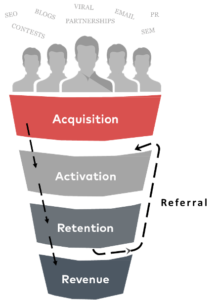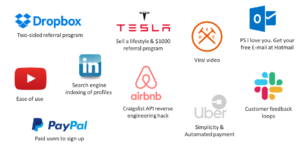Contrary to popular belief, companies such as Dollar Shave Club, Slack, Dropbox, Pinterest, and Stripe didn’t accidentally happen upon a business idea nobody else has thought about or were “in the right place at the right time”.
Rather they employed a scientific approach to product marketing to iteratively discover the most effective ways to acquire, activate and retain customers.

Because startups don’t have the luxury of deep pockets and patient shareholders they can’t afford the traditional ‘above the line’ marketing approach, i.e. TV & radio ads, billboards, and handing out flyers. Instead, they have to find cost-effective ways for their product to ‘go viral’.
Viral growth doesn’t mean 100,000 likes on Twitter or 10 million views on Youtube, rather it means business growth that comes (almost) for free. It’s every marketer’s dream, but there is a simple science to viral products: happy customers talking. If you want your product to go viral (rather than your ad) then deliver expectation-beating experiences to drive word of mouth.

In his book, Growth Hacker Marketing: A Primer on the Future of PR, Marketing and Advertising, Ryan Holiday identify 3 steps to achieving viral growth:
1. ACHIEVE PRODUCT MARKET FIT (PMF)
Product-Market-Fit is all about shaping your product so it meets a specific market need, and the only way to do that is to test what works. But to get to something that’s likely to work, don’t start with the product, start with the customer and work backward. This ensures you have a market focus, rather than a company or product focus. Once a market need is identified, we need to ideate and produce as many possible solutions as possible. Then build prototypes to test the ideas with the target market to determine if any of them will solve their problem.
2. RUN GROWTH EXPERIMENTS
Design Thinking and Lean Startup proposes a test-and-learn approach to identify a product that is worth developing. But once you find a product with a good PMF, you need to market it. And to do this, you use the same test-and-learn approach – analyze the data to formulate a growth hypothesis, designing a market experiment to test the hypothesis, prioritizing the experiments, and then testing them.

A growth experiment is a four to six-week market experiment to test the theory about something that has to potential to move the dial on one or more of the Growth Levers.

Let’s look at each of the Growth Levers and some examples of growth experiments.
Acquisition
Acquisition is about creating awareness for your product (marketing) and signing up new potential clients (sales). In acquisition we need to consider our channels to market for each of our target segments and what the main call to action is. The most important metrics in acquisition are our conversion rate and cost of acquisition. Examples of Growth Experiments in Acquisition:
- Targeted email campaigns. Yes, they still work. But it needs to be relevant, personalized, and targeted. E.g. Super Human Sales
- Google AdWords and SEO. You could look for phrases people search for frequently but that doesn’t attract a lot of spend from other businesses and tag onto it. You could also embed those phrases somehow into your website copy. Or think about who could share your content and provide links back. E.g. TripAdvisor
- Start a movement. Claim a market space, communicate your beliefs and goals and rally people to join the cause. E.g. Redbull
- Rewrite your website copy. Sometimes it might make sense to start on a clean sheet and write a new storyline. E.g. Walmart
- Content marketing. Write thought leadership pieces to build awareness and reputation. E.g. Harvard Business School
- Publicity Stunts. Design a public stunt to build awareness of your brand. E.g. Redbull
- YouTube. Create a viral YouTube video. E.g. Dollar Shave Club
- Build trust. Be relevant, consistent, and superior. Build trust into everything you do. Transcend the public’s inherent mistrust through relentless honesty. E.g McDonalds #goodtoknow campaign
- External sales agents. Especially in B2B establishing an independent army of salespeople working on a commission basis might work for you. E.g. Microsoft Partners
Activation
Activation is all about onboarding new clients. Turning potential clients into paying customers should involve the least amount of friction. This is where UX (User Experience) and CX (Customer Experience) play a major role, and we should use tools such as Net Promoter Score (NPS) to measure customer satisfaction and discover improvement areas. Examples of Growth Experiments in Activation:
- Streamlined application process. Make the onboarding process as simple and pain-free as possible by automating it as far as possible.
- Client-Centric, Lean Methodology. Consider the product always in beta. Watch power-users closely and collect customer feedback, understand their specific use-case and drive a client-centered roadmap. E.g. Slack
- Engage Immediately. Chat pop-up in-app. Send a “hello” from an expert. E.g. Mailchimp
- Chatbots on WhatsApp or in-App can be used as onboarding tools. E.g. Loom
- Get Users to Do One Next Thing. Single, simple call-to-actions, incremental steps over product barriers. E.g. PayPal
Retention
In order to grow a brand, you not only need new customers, but you also need customers who keep coming back for more – and bringing their friends. So from a growth-hacker perspective, customer retention can be your best growth strategy. It has been proven that a five percent increase in retention can typically deliver a 30% growth in profitability (Bain). Examples of Growth Experiments in Retention:
- Make customers friends. Track life events and respond appropriately. i.e. Marriage, death, graduations, moving into a new house, (birthdays). E.g. SA Home Loans
- Pair your customers with accountability partners. Consider hiring a community and/or customer support managers. Human-generated personalized communications. E.g. Rover
- Loyalty programs. Design a loyalty program to support your core offering. E.g. Vitality
- Predictive Churn Modelling. Risk & Value Categorization based on behavioral & payment data. Pre-empt churn and serve value/ offer/ personal service before critical point. E.g. Twitter
- Exit Interviews. Reach out to ‘new leavers’ to get product/ UX feedback (Lean Thinking). Offer to personally fix issues, find a path to value. E.g. Monday.com
Revenue
Ultimately all businesses want to earn money (even non-profits need revenue). Traditional business models are based on scarcity: value is derived from selling a product or service that is in limited supply. New business models like platforms, the sharing economy, products as a service, and ecosystems are based on abundance. Every company should be asking: How can we tap into abundance? Examples of Growth Experiments in Revenue:
- Different pricing models. Consider pay-per-use, subscription, or retainer pricing models.
- Freemium models. What invaluable very narrow tool could offer to the market for free? What invaluable content could you offer to the market for free? Then upsell. E.g. FreedomPop
- Differentiated pricing. Price your offering at different levels for different markets or segments. E.g. SalesForce
- New revenue sources. Consider alternative revenue sources like advertising, training, and consulting. E.g. IBM
Referrals
Referrals are the holy grail that every Growth Hacker strives for. Most hyperscale startups achieved their success through referrals. Examples of Growth Experiments in Referrals:
- Reward referrals. The most successful referrals models are those that reward both the referrer and referee. Incentivize loyalty and referrals in a meaningful way. E.g. Dropbox
- Influencers. Identify influencers and let them spread the message.
- Great customer experience. Create a ‘sticky’ platform – make referrals and onboarding frictionless and seamless. E.g. Uber
- Case studies. Compile case studies and share them with potential clients. E.g. IBM Watson
3. GO VIRAL
The science behind viral growth is to carefully measure the results from our Growth Experiments to discover on which Growth Lever to focus and what strategy is producing the best results and then to double down on the most promising experiments to optimize them.
To help with this process we need to view the Growth Levers as a marketing funnel.

We need to measure conversion at each step to identify bottlenecks. In the example below, we can clearly see the problem is in Activation. If this is the case, we need to find out what is preventing customers from activating and what can be done about it. Maybe we need to look at the User Experience (UX) design or review the pricing.

A Growth Experiment that results in Viral growth is what is known as a Growth Hack.
Most companies run between 25 and 30 Growth Experiments focused on a specific Growth Lever they have identified as the bottleneck before finding a Growth Hack.
Some of the most iconic Growth Hacks

However, we should not be fixated on finding a Growth Hack and going viral, but instead, adopt the Growth Hacking mindset and employ a scientific approach to marketing to optimize growth.
In other words, think like a startup!
Establishing a Dedicated Growth Team
Many companies nowadays hire a dedicated Growth Team to focus on this process of growth experimentation full-time.
The concept became popular thanks to tech startups like Facebook, Airbnb, and Uber. Once they had achieved product-market fit, they then turned to marketing tactics to promote those products. But they realized that there was an inextricable link between product development (refinements) and marketing.
According to an article covering the subject on technology news site VentureBeat, “Growth teams solve problems that enable further growth through a process of experimentation and analysis.”
Since they originated in the tech industry, it’s easier to imagine growth teams in terms of a software or SaaS product than in any other context. A growth team may be made up of marketers or salespeople, but in tech, it will often include developers, data analysts, and UX/UI experts working underneath a growth manager.
The people filling these roles need to be able to think freely about how the company acquires and retains customers, so growth teams are often made up of the most creative and innovative individuals in a company. For example, a growth marketer doesn’t just engage with day-to-day marketing operations. They search for new ways of driving results through experimentation, gaining insights from their analytics to draw conclusions.
Want to learn more?
That’s the spirit. Check out more of our articles:


